2014 Yamaha FZ-09 Review

Yamaha's back in the three-cylinder game in a big way
Maybe it’s a sign of my, ahem, maturity, but as much as I love riding sportbikes, quite frankly they’re a chore to ride during the daily grind. The low bar, high peg, racer crouch is great on a racetrack, but impractical for the street. Plus, they’re not great at carrying things, either. I’m not saying I don’t like riding sporty bikes on the street, but these days I want my sport with a bit of practical and comfortable, too. That’s why I gravitate towards standard/naked bikes. With similar power to supersports, only marginally less performance, and an upright seating position, these really are sportbikes for the road.
2014 Yamaha FZ-09
| Engine | 17/20 |
| Suspension/Handling | 10/15 |
| Transmission/Clutch | 9/10 |
| Brakes | 7/10 |
| Instruments/Controls | 4/5 |
| Ergonomics/Comfort | 9/10 |
| Appearance/Quality | 8/10 |
| Desirability | 8/10 |
| Value | 10/10 |
| Overall Score | 82/100 |
The truly special ones, like the Triumph Speed Triple, MV Agusta Brutale 800 and Aprilia Tuono share another key element: character. Determined simply by the size of the grin on your face after each ride, character is the X-factor that turns us into rambling idiots whenever we review one on video.
Visit our Yamaha FZ-09 Forum
Well, now you can add another bike to that list, and this one comes from Japan: the 2014 Yamaha FZ-09. Borrowing the “if you can’t beat ’em, join ’em” mentality, Yamaha has entered the three-cylinder fray, too, powering the FZ with a 847cc Triple, the company’s first three-cylinder motorcycle engine since the XS850 in the late 1970s. However, other than the number of cylinders each bike has and the lack of any real bodywork, the FZ and XS are worlds apart. Read my Yamaha Triples Retrospective for comparisons between old and new.
The march in time has been so great that Yamaha never once said a word about the XS750 or 850 during the presentation of the new FZ. When asked about it, Yamaha reps noted appreciation for the past, but the Tuning Fork company isn’t looking backwards, but instead toward the future.
Read our Yamaha Triples retrospective
And that future consists of supersport riders who have come to realize that an R6 or R1 isn’t the most comfortable ride outside the racetrack. Street riders, commuters and weekend riders alike want to feel as alive as they do on their supersports while getting through town. That means an open seating position with a torque-rich engine. And in this economy, an affordable price point means a lot, too. With an MSRP of $7990, the FZ-09 makes a strong case for best value of 2014.
A new era of Yamaha Triples
Enter Yamaha’s all-new 847cc Triple. A clean-sheet design, the inline-Three was chosen for its torquey nature, slim dimensions and because Yamaha engineers understand Triples exude that magic ingredient: character. A first for any production multi-cylinder Yamaha, the FZ-09 cylinders are offset 5mm from the crank axis, meaning the crank pin is beginning its downward path when combustion occurs for less parasitic power loss. Bore and stroke measures 78.0mm x 59.1mm, and pistons are forged aluminum with a compression ratio of 11.5:1.
The 120-degree crankshaft means the FZ-09 has an even 240-degree firing order. Part of Yamaha’s “Crossplane Crankshaft Concept” first introduced on the R1 (a true crossplane design in that its crank pins are situated 90 degrees from each other) Yamaha now uses this phrase to describe the direct connection between rider and the rear wheel. A balancer shaft helps cancel vibes and serves double duty by running the water pump.
The four-valve cylinder head is an all-new design, with intake and exhaust valves measuring 31mm and 25mm, respectively. Intake valve angle is set at 13 degrees, exhaust at 13.5, and the downdraft intake port provides a direct path for the 41mm Mikuni throttle bodies and Denso 12-hole injectors to feed the air/fuel mixture. Within the 13-liter airbox, intake funnels are staggered with the first cylinder funnel at 102.8 mm, second at 82.8 mm and third at 122.8 mm. The airbox features a built-in resonator, because, well, a three-cylinder intake howl is worth amplifying.
Throttles are opened and closed electronically with YCC-T ride-by-wire, which also allows the use of three different ride modes: A, Standard and B. It’s a similar technology seen on the R1 literbike. Yamaha claims peak horsepower to be 115 at 10,000 rpm and torque 64.5 ft.-lb. at 8500 when measured at the crank. Moreover, a bigger emphasis was placed on useable rather than peak power, as the FZ-09 is intended for city scapes and backroad bombing.
To accomplish the latter, the aluminum frame uses the engine as a stressed member, with the swingarm externally attached. KYB provides suspension bits, with a 41mm inverted fork up front and nearly horizontal shock in the rear. Both are adjustable for rebound and preload. Trick-looking 10-spoke cast aluminum wheels wear 120/70-17 front and 180/55-17 rubber. Strangely, half the bikes will come with Dunlop Sport Max D214s and the other with Bridgestone Battlax Hypersport S20s. Stopping power is a hodgepodge of parts; Brembo provides the master cylinder, Advics the front radially mounted four-pot calipers and Nissin the rear squeezer.
A true Japanese hooligan
As the leader in the triple-cylinder hooligan bike class, Triumph’s Speed Triple has historically been top dog. I’m not saying it has met its match, but the FZ-09 steals some of Hinckley’s thunder. Considering how much we love the Speed Triple, the Tuning Fork company’s latest creation builds a strong case for itself. Here’s why.
COMPARISON: Read our review of the Triumph Speed Triple R
Designed to be a perfect urban/city tool to slash through traffic and deal with the rigors of city life, the FZ-09’s rider triangle is even more upright than the outgoing FZ8. Bars are 53mm higher and 40mm closer to the rider compared to the 8, and the footpegs are 26mm lower. Seat height is a little on the tall side at 32.1 inches (0.4 inch shorter than the Triumph), but once on, the narrow junction between the seat and 3.7-gallon tank makes touching the ground pretty simple. One gripe is the right-side engine case protrudes out slightly past the frame, forcing shorter riders to angle their legs awkwardly to place a toe down.
Otherwise, the riding position is much more relaxed compared to supersports, and even the Speed Triple. Tall riders will appreciate the leg room, as the high bars and low pegs keep elbows and knees far apart from each other.
In keeping with the city bike theme, Yamaha flew journos to San Francisco to get a taste of the FZ-09 in its natural environment: darting through the city en route to the twisties. With the Speed Triple’s displacement advantage over the FZ-09 (1050cc vs. 847cc), the Triumph clearly wins the power battle, but the Yamaha Triple is every bit as ready for hooligan antics. Its distinguishing trait is the sheer amount of torque available from the bottom end — it’s near impossible to keep the front end down in first gear.
This broad spread of torque mixed with the narrow profile makes filtering through cars easy work. The tapered bars provide ample leverage to heave the bike away from a potential hazard if needed.
As we head out of the city on our search for some of the Bay Area’s best two-lane roads, the lack of bodywork, even a windscreen, becomes apparent at highway speeds. The headlight is the only thing diverting air away from the upper body, which means the rider is blasted with wind on the open road. On the bright side, a whole list of Yamaha accessories, including a small flyscreen, are available.
If you can handle the turbulence, the FZ-09 could handle light touring duties well. All six gears are widely spaced to take advantage of the available torque, meaning 80 mph in top gear spins the engine to 5500 rpm. Add on the optional screen, saddlebags and top case, and a long weekend trip is entirely doable.
Conversely, as-is, it’s quite a fun canyon bike. The bars give it leverage to throw it left and right, though the chassis and relatively budget suspension really rewards a smooth rider over one who’s rough with their inputs. I found the KYB bits started to protest and pogo when ridden with any real anger. As damping rates are geared towards a comfy street ride, be gentle with inputs and it’ll lay over and provide a nice arc through turns.
Compared to the Speed Triple, the FZ-09 feels a tad slower to turn. A closer look at the spec sheets would prove this hunch correct, as the Yamaha has a longer wheelbase (56.7 inches vs. 56.5), lazier rake (25.0 degrees vs. 22.8) and longer trail (4.1-inch vs. 3.6). But don’t get the wrong idea — the FZ is by no means slow.
COMPARISON: Read our review of the MV Agusta Brutale 800
Throughout our ride no journo could resist the temptation to twist the throttle and hear the engine make sweet music, even with the stock exhaust. The thing rips and can embarrass lesser riders on bigger bikes. Second gear is wide enough for most of the tight bits of our press ride, while third easily handles the faster sweepers. The bike could have cruised in a higher cog, but keeping the gear low and the revs high ensured hearing as much engine noise as possible.
Yamaha’s YCC-T ride-by-wire system allows the use of different power modes, but personally, A and Standard modes are too aggressive. Combine this with the abrupt fueling at part-throttle openings, and trying to gently twist my wrist resulted in a noticeable jolt forward. B mode, the softest, provides the best balance of response and drivability.
Stopping power is good for this budget-minded machine. The Advics calipers offer great stopping power, and the Brembo master cylinder delivers fairly good feel at the lever. I haven’t always been a fan of Yamaha brakes, but these are a decent set. Interesting fact: the FZ-09 uses 298mm rotors, down from the FZ8’s 310mm. Yamaha says this is mainly because the FZ-09’s feather light 414-pound wet weight (53 pounds lighter than the FZ8) doesn’t require as arge a rotor. Unfortunately, ABS is not available on the FZ-09, not even as an option.
Shaking up the scene… again
If you’ve read our Yamaha Triples Retrospective you’ll remember the bit about Yamaha introducing the original XS750 to shake up the motorcycle landscape of the time. Well, they’ve done it again with the FZ-09. The inline-Triple is a great engine with loads of torque and plenty of character. Other than a minor fueling issue and overly aggressive ride modes, it really is a gem.
The chassis side suffers with rather basic suspension pieces, though even as-is it can take a corner at a good clip. However, for its given intent of being an exciting and well-rounded urban commuter capable of the weekend canyon run, Yamaha nailed it with the FZ-09. Factor in the $7990 price tag and any issues we have with the fueling or handling are easily forgiven.
All that’s left to do now is stack it up against the other leading Triples in its class to battle it out for top honors! Stay tuned.

Troy's been riding motorcycles and writing about them since 2006, getting his start at Rider Magazine. From there, he moved to Sport Rider Magazine before finally landing at Motorcycle.com in 2011. A lifelong gearhead who didn't fully immerse himself in motorcycles until his teenage years, Troy's interests have always been in technology, performance, and going fast. Naturally, racing was the perfect avenue to combine all three. Troy has been racing nearly as long as he's been riding and has competed at the AMA national level. He's also won multiple club races throughout the country, culminating in a Utah Sport Bike Association championship in 2011. He has been invited as a guest instructor for the Yamaha Champions Riding School, and when he's not out riding, he's either wrenching on bikes or watching MotoGP.
More by Troy Siahaan




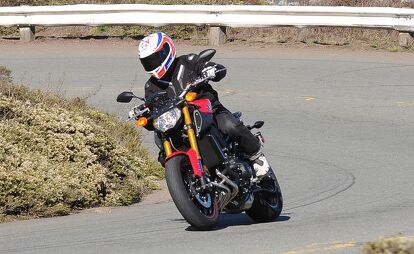





















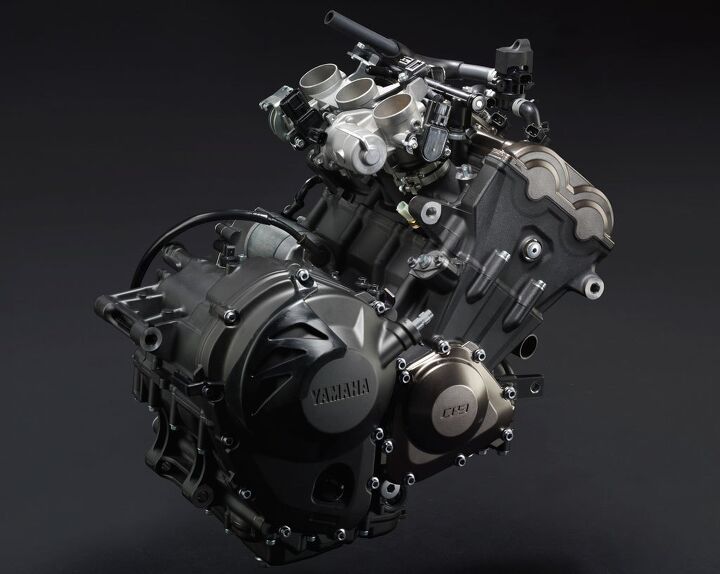













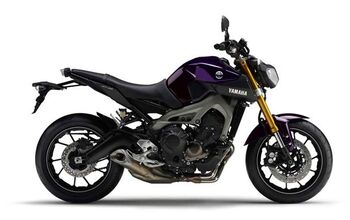

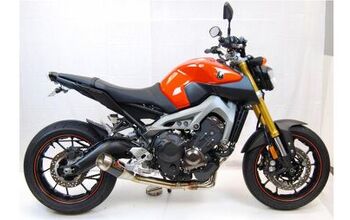
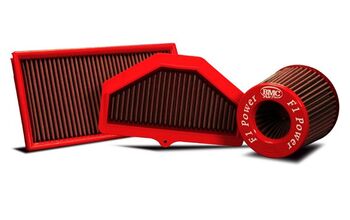
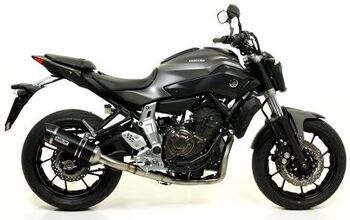












Comments
Join the conversation
Hurry for Yamaha, they realized it is about weight. And not being European it will be real world dependable.
I'm Kinda worried about the chassis. Looks really radical and very low budget. the stearing head is way high on the chassis and the swing arm pivots on the outside of the frame. Also, the reason it likes to wheelie is because its got the shortest swing arm I've ever seen on any motorcycle. the price is good but I'll wait n see whats really up with the chassis.